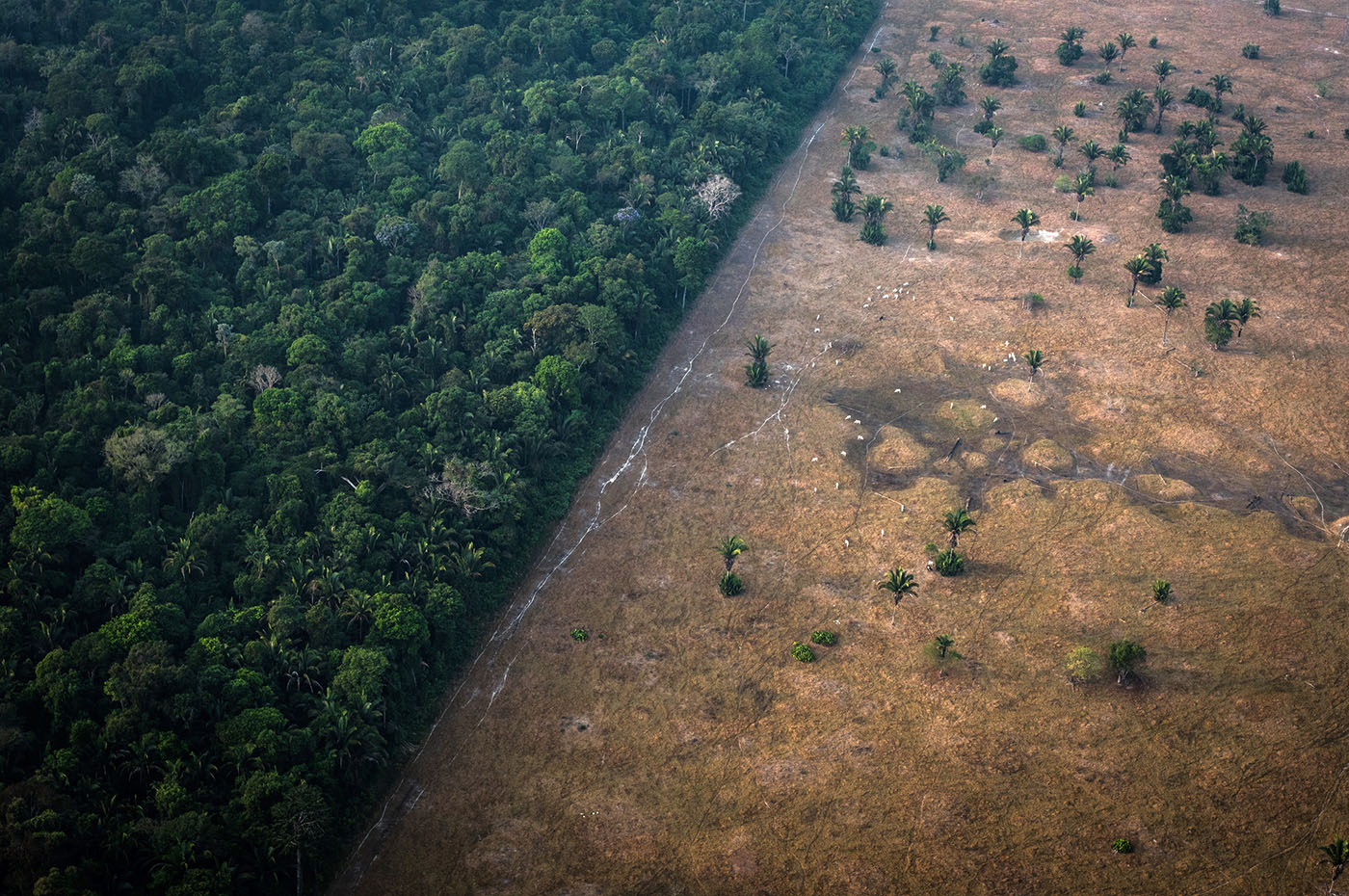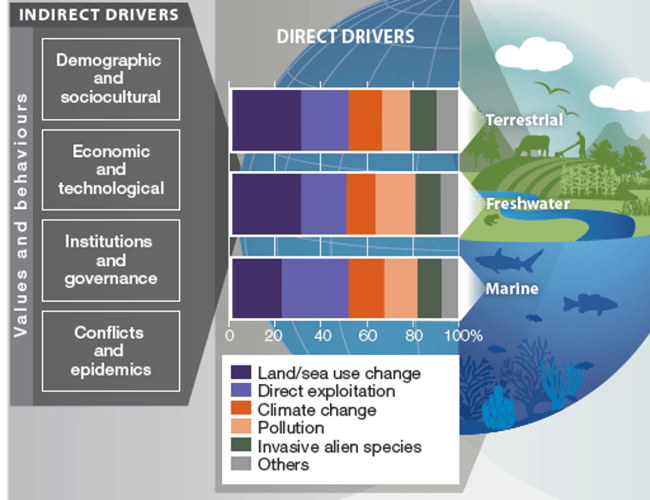
Climate change and biodiversity loss are two of humanity’s most pressing challenges. But while they are highly connected, they have tended to be studied and addressed separately. This article looks at how they are connected and why risk professionals need be aware of the interconnections, so that actions they take to reduce the risks of one do not inadvertently exacerbate the other.
Background
Climate change is the alteration in regional and global climate due to the global warming from human emissions of greenhouse gases. Climate change leads to increases in physical risk — such as more flooding and more intense wildfires — and transition risk — for example, from changes to regulations or technology that will facilitate a reduction in greenhouse gases. These risks, in turn, impact the real economy and the financial industry.
A recent UN Climate Change report states that the world is currently off course to meeting the Paris Agreement objective of limiting warming to 1.5°C, with government commitments putting the world on track for warming of around 2.5°C. However those commitments still need to be turned into laws and policies, and current policies correspond to even higher temperatures, according to Climate Action Tracker. We see the consequences of this in the heatwaves that are occurring more often, and the five-fold increase in weather, climate and water-related disasters over the last 50 years.
Biodiversity is the variety of life on earth and is a key indicator of the health of nature; it includes diversity within species, between species, and of ecosystems. The ecosystem services (stock of natural resources) provided by nature not only provide food and water, they protect communities from floods, fires and disease, help mitigate the effects of climate change, and in some cases provide resilience against the impacts of climate change. They are also the foundation of our economic activities.
Alarmingly, biodiversity is being reduced faster than at any time in human history. This is not only making it harder to achieve the UN’s Sustainable Development Goals, it is also leading to losses across the real economy and the financial industry. This was explored in GARP’s recent introductory paper on biodiversity loss, which found that around 40% of financial institutions loans or investments are highly dependent on ecosystem services, and an even higher percentage depend on them to some extent.
Climate Change Is One of the Drivers of Biodiversity Loss
Climate change is one of the five drivers of biodiversity loss, the others being land/water/sea use change, resource exploitation, pollution, and invasive species, as shown in Figure 1. While climate change has historically been the third largest contributor to biodiversity loss, according to a recent scientific report it is expected to become the largest this century.
Figure 1: Pressures on Nature – Drivers of Biodiversity Loss

Source: IPBES Global Assessment Report on Biodiversity and Ecosystem Services: Summary for Policymakers
Climate change affects all ecosystems — land, freshwater, and ocean. Increasing climate change is negatively affecting land ecosystems such as savannas through changing rainfall patterns, and is drying out tropical forests. This impacts which plants and animals can live in these environments, altering their natural cycles and their interactions via changes in phenomena such as the timing of plant growth and flowering, when birds lay eggs and migrate, and which plants and animals will be able to co-exist in the altered environment.
Climate change is also having a profound impact on the oceans. More than 25% of carbon dioxide emissions are absorbed by the oceans, and they capture more than 90% of the excess heat generated by these emissions, according to the UN. Consequently, they are an important carbon sink. However, this absorption warms the ocean and increases its acidification. Increasing ocean acidification is sometimes called “osteoporosis of the sea” and affects marine life’s shells and skeletons, and consequently their ability to grow and reproduce.
Warming oceans have reduced the productivity of some fisheries by 15 to 35%. Like other aspects of climate change, the impacts vary by region and, although productivity increased in some regions, there has been a 4% net global reduction of fish over the last 80 years. Even if global warming is limited to 1.5°C that would still be too hot for 10% of fish species, according to a New Scientist report. These changes to ocean species affect the food chain that relies on them, including the one billion people that rely on food from the ocean as their primary source of protein, and the businesses which provide that food. All these changes to the ocean have also compromised its ability to act as a carbon sink and reduce global warming.
Biodiversity Loss Impacts Climate Change
Climate change doesn’t just affect biodiversity; biodiversity loss, in turn, impacts climate change. For example, draining and degrading tropical wetlands and converting them for other purposes (such as turning them into rice fields) not only impacts nature, it is also an important driver of increasing methane in the atmosphere which exacerbates climate change.
Clearing forests also impacts the climate in different ways. It reduces global warming by reflecting more solar energy into the atmosphere, but it also decreases rainfall, and reduces carbon capture and storage. In fact, some tropical forests now emit more carbon than they capture.
Jointly Mitigating Climate Change and Biodiversity Loss
Due to the relationship between climate change and biodiversity loss, resolving either issue requires consideration of the other, according to a report from the Intergovernmental Science-Policy Platform on Biodiversity and Ecosystem Services (IPBES) and the Intergovernmental Panel on Climate Change (IPCC). For example, afforestation with one species that sequesters large amounts of carbon dioxide can harm biodiversity. Whereas coastal restoration, avoiding deforestation, sustainable fishing, and reducing pollution are expected to both reduce threats to biodiversity and mitigate climate change.
Actions that help biodiversity can also contribute to climate change adaptation. One example is that restoring or protecting wetlands not only improves habitats and biodiversity. It can also moderate or reduce stream temperatures, and alleviate flooding.
Increasingly, not just the scientific community, but also investors and regulators are recognizing that climate change and biodiversity loss need to be addressed together. And the climate-related expectations we have seen increasing in the last few years are now also being applied to biodiversity. For instance, the Taskforce on Nature-related Financial Disclosures (TNFD) is creating external disclosure recommendations similar to those from the Taskforce on Climate-related Disclosures (TCFD).
Many regulators are already asking their firms to understand the impact of biodiversity on their portfolio. For example, the Monetary Authority of Singapore (MAS) expects banks to manage environmental risks using standard risk management techniques, the European Central Bank (ECB) has issued supervisory guidance for environmental-related risks, and — on the liability side of the balance sheet — the Reserve Bank of India has stated that green deposits can be used for improving natural ecosystems and biodiversity as well as mitigating climate change. Given these developments, it may not be long before firms will be required to measure and report how their portfolios are affecting, and being impacted by, both climate change and biodiversity loss, so firms should start preparing now.
Parting Thoughts
Globally there is a focus on achieving net-zero emissions by 2050, plus there is an increasing recognition that a sizeable proportion of lending and investment portfolios are highly dependent upon ecosystem services. Therefore, where loans, investments or insurance could be contributing to biodiversity loss or climate change, risk managers need to ask whether the other phenomena is also present and how the transaction can be structured to avoid both climate and biodiversity impacts. This will help limit the unintended consequences of mitigating actions, protect the physical environment, decrease financial risks, and provide a legacy for future generations.
Maxine Nelson, Senior Vice President, GARP Risk Institute, currently focusses on sustainability and climate risk management. Previous roles have included Global Head of Wholesale Risk Analytics and Head of Capital Planning at HSBC, responsibility for counterparty credit risk at the UK FSA, leading KMPG London’s credit risk team, senior consultant at Oliver Wyman, and operational risk modelling at NAB.